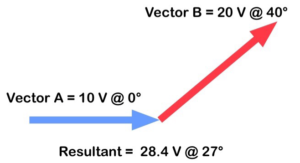Vectors
A Vector Primer
What is a vector?
A vector is a quantity that possesses magnitude and direction. As an example, let’s say I roundhouse kicked you in the head. The magnitude of the force and the angle at which I kicked you would be a vector. I know what you’re thinking: “This electrical stuff sounds cool.” And you’d be right.

Aside from helping me become a fighting machine, how do vectors have anything to do with electricity?
AC values are constantly changing magnitude and direction. We will talk about this more in-depth in the AC generation portion of the course. Eventually, we will be required to add these values together. The sum of the vectors is called the resultant. This is all well and good when vectors are heading in the same direction…

… because you can just add them together.

It isn’t even bad if they are heading in the opposite direction. You can just subtract them. The only thing when adding them in opposite directions is that you have to pay attention to which vector has the greatest value. This will become the new direction of the sum of the vectors.
The problem arises when they are heading in completely different directions.

How did you do that?
Trust me, it is not difficult. In order to figure out how to add vectors, we first have to talk about the quadrant system.
Up next: Quadrants

